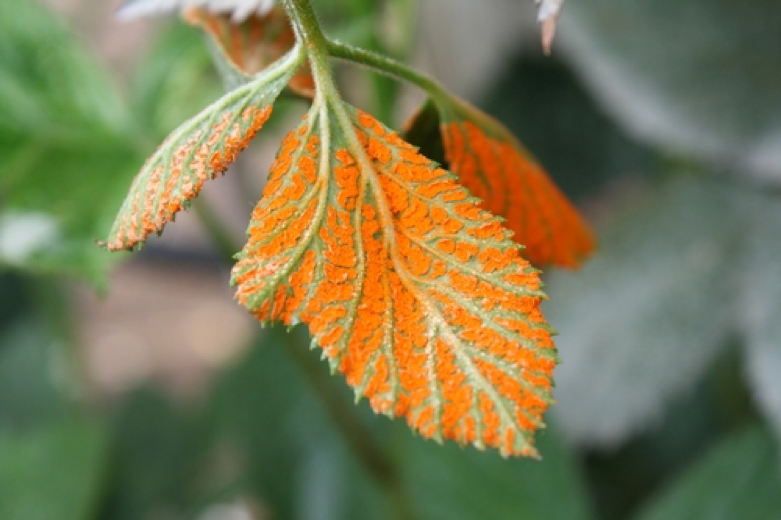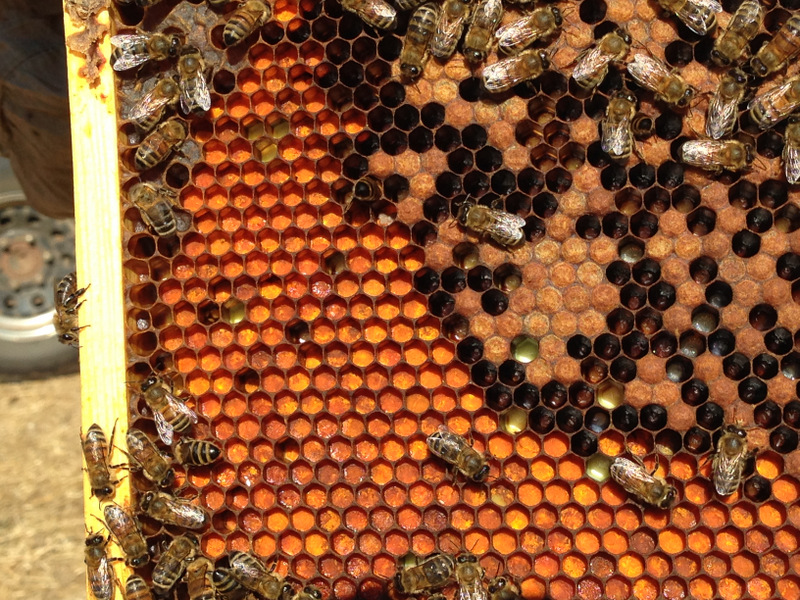“Fried Eggs” Identified!
“Fried Eggs” Identified!
Randy Oliver
ScientificBeekeeping.com
First Published in ABJ in Feb 2012
I mentioned in my previous article that I’ve been seeing an unidentified organism that looked like “fried eggs” in the guts of bees from my operation in the California foothills (Figure 1). I sent out requests to a number of researchers for ideas as to what it was. Thanks to Antonio Gómez Pajuelo of Consultores Apícolas in Spain for identifying them as rust fungus spores.
Figure 1. These “fried eggs” have a distinctive pattern of tiny spikes on their outer shell, which helped to identify them as some sort of rust fungus spore. What appeared to be the process of cell division in this photo may have actually been the process of digestion! Photo by the author.
Upon further research, I found that beekeepers have long reported bees gathering rust spores and packing them into their pollen baskets, and that a number of scientific papers had been written on the subject (it always pays to dig into the older literature). The rusts are a large group of parasitic fungi with complicated life cycles. They infect quite a number of different plants, often forming reddish spore masses on the undersides of leaves. Bees have been observed collecting spores from a number of genera of rusts, including Uromyces, Puccinia, Caeoma, and Melampsora (Fig. 2),
Figure 2. Spores of the Poplar Rust Melampsora, which is commonly collected by bees. It’s not clear whether rust spores in general are harmful to bees. Photo courtesy www.bioimages.org.uk, © Malcolm Storey.
A.J. Cook reported in 1885 that bees in New York were gathering spores from blackberry rust “with great apparent greed.” Of interest is that the last two seasons, I had noticed unusual infestations of fluorescent orange rust on our invasive Himalaya blackberries in the foothills. I hadn’t put it together previously, but I had also noticed bees bringing in loads of a brilliant orange “pollen” that I’d never noticed before (by the time I got the dang things ID’d, I could no longer find that orange “pollen” to check under the ‘scope). Blackberry rust is generally attributed to Caeoma, but I found that UC Davis extension (Bolda 2011) reported we have a new invasion of orange rust of blackberries caused by two other fungi—Arthuriomyces and Gymnoconia (Fig. 3).
Figure 3. An orange rust on blackberry. This looks like the same thing that I saw around my apiaries. Photo courtesy Mark Boulda.
Something that I find intriguing is that some rust fungi produce sugary secretions for the purpose of attracting insects in order to help disperse their spores (Wäckers 2005). Even more fascinating is a potential explanation for the day-glow orange spore masses of blackberry rust. Shaw (1980), studying the collection of rust spores by honey bees, found that the spore masses reflected ultraviolet light of a wavelength to which bees are highly sensitive. So the fungus may be “intentionally” using bees to its advantage!
Bees consume rust spores readily; during our fall pollen dearth I often find bee guts packed with them. Schmidt (1984) found that bees in cages consumed Uromyces rust spores as readily as they did dandelion pollen, despite it being low in protein. The question then is whether rust spores are of any nutritional value to bees, or, since I often find them associated with sick colonies, whether they cause actual harm to the bees (my sampling is admittedly biased towards colonies in poor health).
Above is a photo of a typical comb filled with beebread consisting of rust fungus spores. Note the lousy brood pattern and the dying brood. When the colony is feeding upon this beebread, it goes downhill quickly. However, if we feed the hive several pounds of high-quality pollen sub, it will turn around immediately and grow again.
Antonio Pajuelo (pers comm) also reports a correlation between the consumption of poplar rust spores and colony mortality, but doesn’t know whether it is due to spore toxicity or lack of better nutrition. It may be that the collection of rust spores is due to the lack of more attractive and nutritious floral pollen, and as such would simply be a generic indicator of poor colony nutritional status.
On the other hand, Schmidt (1987) found that caged bees fed Uromyces spores as a sole protein source actually had their lifespan reduced compared to those fed sugar syrup only—strongly suggesting that the spores were toxic. The spore-fed bees lived about 20 days less than those fed the most nutritious pollens!
Practical application: it may be wise to feed pollen supplement if you observe your bees collecting rust spores.
Acknowledgements
Thanks to Antonio Pajuelo and all the other researchers who helped with trying to put a name to these organisms. And a big thanks to Peter Borst and Juanse Barros for plying through Google Images in the search for the identity of these spores, and Dr. Jose Villa for digging up the old literature.
References
Bolda, M (2011) Orange rust emerging again in blackberry. http://cesantacruz.ucdavis.edu/?blogpost=4660&blogasset=16664
Cooke, AJ (1885) Fungus spores for bee bread: A new kind of pollen. Gleanings in Bee Culture July 1885 pp. 455-456.
Schmidt, JO and BE Johnson (1984) Pollen feeding preference of Apis mellifera, a polylectic bee. The Southwestern Entomologist. 9(1).
Schmidt, JO, SC Thoenes and MD Levin (1987) Survival of honey bees, Apis mellifera (Hymenoptera: apidae), fed various pollen sources. Annals of the Entomological Society of America 80(2): 176-183.
Shaw, DE (1980) Collection of neurospora by honeybees. Trans. British Mycol Soc. 74 (3): 459-464.
Wäckers, FL, J Bruin (2005) Plant-provided food for carnivorous insects: a protective mutualism. Cambridge Univ. Press.







